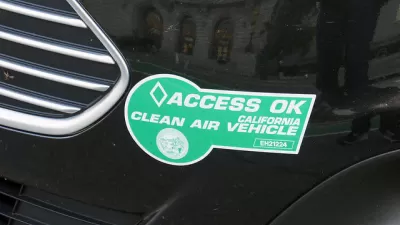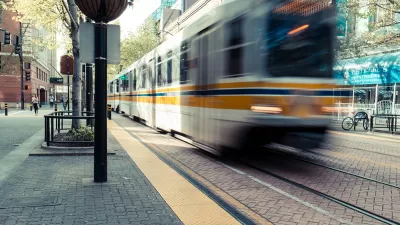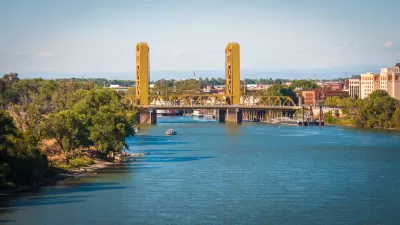The future of cap-and-trade in California may be uncertain, but the $391 million allocated Tuesday from the program for greenhouse gas-reducing transit capital projects is real. A plan to release $1.2 billion of carbon revenue has been introduced.

"Transportation officials have selected 14 public transit projects across California for a slice of proceeds from the state's auction of greenhouse gas pollution credits, almost $391 million in spending between now and the summer of 2018," reports John Myers, Sacramento bureau chief for the Los Angeles Times.
The list of projects unveiled Tuesday includes more than $109 million for Los Angeles' subway system, including funds for the planned connection to LAX. Another $28 million would help fund a streetcar project in Orange County linking Santa Ana and Garden Grove.
More on the grants to Metro's Red and Purple lines, and the Orange County Streetcar were reported by LA Curbed. The Purple line also received good news on the legal front posted here on Tuesday.
Another streetcar project to receive funds from the Transit and Intercity Rail Capital Program, funded by cap-and-trade auction proceeds, was the Downtown/Riverfront Streetcar Project that would serve Sacramento and West Sacramento. It received $30 million.
"In total, 41 local governments submitted more than $3 billion in grant requests," reports Tony Bizjak for The Sacramento Bee. A complete list of the awards and a detailed summary is available on the California State Transportation Agency news release.
As for other funds, "Senate leader Kevin de León is making a new effort to unsnarl a two-year budget gridlock over money generated from the state's cap-and-trade program," reports Melanie Mason, state government and politics correspondent for the Los Angeles Times.
The $1.2-billion spending plan, released Wednesday, would include money for cleaner cars, energy efficient upgrades and urban parks. [See legislation.].
California's landmark cap-and-trade program, in which businesses purchase permits to pollute, has raised more than $4 billion -- all of which must be used to fund efforts to reduce greenhouse gas emissions. But for the last two years, Gov. Jerry Brown and top lawmakers have been unable to agree on how to spend $1.4 billion generated by the program.
Mason explains the problem in a related article on the embattled program:
Sixty percent of the proceeds are directed each year to certain projects, including the bullet train, transit and affordable housing programs. The rest is haggled over in the budget process.
Also on Tuesday, the California Air Resources Board (CARB) held their quarterly auction of carbon allowances. Sales from the May auction were extremely disappointing.
Not only is the future of the only state-controlled cap-and-trade program in the U.S. uncertain, but legislation to authorize carbon reduction goals past the year 2020 is looking doubtful.
FULL STORY: Almost $391 million in cap-and-trade dollars awarded to public transit projects across California

Alabama: Trump Terminates Settlements for Black Communities Harmed By Raw Sewage
Trump deemed the landmark civil rights agreement “illegal DEI and environmental justice policy.”

Study: Maui’s Plan to Convert Vacation Rentals to Long-Term Housing Could Cause Nearly $1 Billion Economic Loss
The plan would reduce visitor accommodation by 25% resulting in 1,900 jobs lost.

Planetizen Federal Action Tracker
A weekly monitor of how Trump’s orders and actions are impacting planners and planning in America.

Wind Energy on the Rise Despite Federal Policy Reversal
The Trump administration is revoking federal support for renewable energy, but demand for new projects continues unabated.

Passengers Flock to Caltrain After Electrification
The new electric trains are running faster and more reliably, leading to strong ridership growth on the Bay Area rail system.

Texas Churches Rally Behind ‘Yes in God’s Back Yard’ Legislation
Religious leaders want the state to reduce zoning regulations to streamline leasing church-owned land to housing developers.
Urban Design for Planners 1: Software Tools
This six-course series explores essential urban design concepts using open source software and equips planners with the tools they need to participate fully in the urban design process.
Planning for Universal Design
Learn the tools for implementing Universal Design in planning regulations.
Caltrans
Smith Gee Studio
Institute for Housing and Urban Development Studies (IHS)
City of Grandview
Harvard GSD Executive Education
Toledo-Lucas County Plan Commissions
Salt Lake City
NYU Wagner Graduate School of Public Service





























